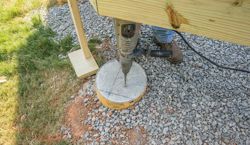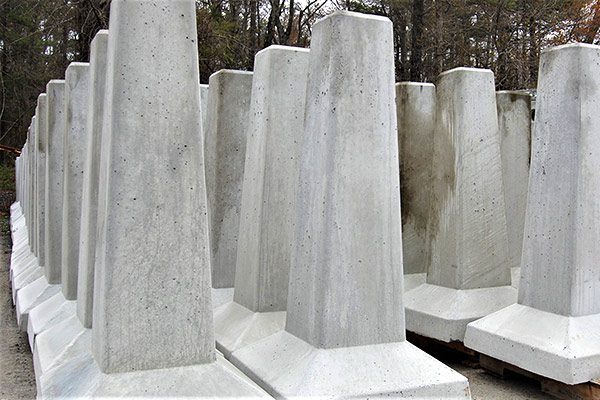Make The Most Of the Life Expectancy of Your Deck With Solid and reputable Grounds
As homeowners, we spend a considerable quantity of time and resources right into creating the perfect exterior room. A deck is typically the centerpiece of that area, giving a place to kick back, amuse, and appreciate the beauty of nature. Nevertheless, in order to completely make best use of the life expectancy of your deck, it is important to make certain that it is improved dependable and solid footings. These footings create the foundation of your deck, supplying stability and assistance, and are frequently the difference in between a deck that lasts for decades and one that needs continuous repair services. In this conversation, we will certainly check out the importance of trusted footings, the various types of strong footing products, appropriate installment strategies, and exactly how to preserve and examine your deck's grounds to avoid damages. So, whether you remain in the procedure of looking or developing a new deck to boost the longevity of your existing one, join us as we reveal the keys to a deck that stands the examination of time.
Relevance of Dependable Footings
When it comes to taking full advantage of the lifespan of your deck,The significance of trusted grounds can not be overstated. The grounds act as the foundation whereupon the entire framework relaxes, giving security and assistance. Without a solid footing, the deck is prone to moving, sinking, and even collapse, which can substantially minimize its lifespan and position safety and security risks.

Picking the best kind of ground is additionally vital. The most typical kinds include concrete footings, helical piers, and sonotubes. Variables such as dirt problems, environment, and the dimension of the deck will figure out the most suitable option. Employing a professional to assess the soil, design the footings, and make certain correct installation is extremely advised.
Spending in dependable footings may involve extra cost and initiative upfront, yet it is a beneficial financial investment that will certainly contribute to the lasting toughness and safety of your deck. By making certain a strong foundation, you can enjoy your deck for numerous years to come, knowing that it is developed to hold up against the test of time.
Kinds Of Solid Ground Materials
To ensure the stability and longevity of your deck, it is necessary to consider the numerous types of solid footing products readily available. The selection of footing material is important as it provides the essential assistance and security to withstand the weight and load of the deck framework.
One dependable and typical product made use of for deck footings is concrete. Concrete grounds are long lasting and give exceptional security. They can be put directly into the ground or make use of precast concrete grounds for less complicated setup. One more option is helical piers, which are steel shafts with helical plates that are screwed right into the ground. These piers offer superb load-bearing ability and can be used in various dirt problems.
For areas with poor dirt conditions, such as loose or expansive dirts, a ground system that uses steel or composite piers might be liked. Deck Footings. These piers are driven deep into the ground to reach secure dirt layers, making sure the stability of the deck
In many cases, deck footings can additionally be created making use of cured lumber. It is essential to guarantee that the lumber is correctly dealt with to withstand rot and decay caused by exposure to dampness and bugs.
When picking a ground material for your deck, it is important to take into consideration elements such as soil conditions, climate, and neighborhood building regulations. Consulting with an expert contractor or architectural designer can assist identify the most appropriate footing material for your certain deck project.
Appropriate Installment Techniques for Grounds
Considering the value of guaranteeing security and toughness for your deck, it is essential to recognize the appropriate setup strategies for grounds. The success of your deck task relies greatly on the integrity of its foundation, which is why complying with the correct setup techniques is essential.
Most importantly, it is required to establish the appropriate dimension and deepness of the grounds based on the design and tons needs of your deck. This info can be gotten from building codes or through assessment with a structural designer. As a basic regulation, footings need to be at least 12 inches in size and extend listed below the frost line to stop shifting or clearing up.
When the measurements are established, the next action is excavation. Digging the holes for the grounds must be made with accuracy, making certain they are deep sufficient and have a degree bottom. Deck Footings. This will provide a steady base for the grounds
To further boost the security of the footings, it is advised to make use of a concrete combine with a toughness of at the very least 3,000 psi. This will certainly make certain the footings can hold up against advice the weight and forces applied by the deck.
Throughout installation, it is essential to keep the grounds level and lined up correctly. This can be achieved by making use of a level and string lines to direct the positioning of each ground.
Preserving and Inspecting Your Deck's Footings
Regular maintenance and complete assessments are necessary for making certain the lasting stability and safety and security of your deck's grounds. Gradually, grounds can surrender to put on and tear, climate condition, and soil movement, which can jeopardize their architectural honesty. To optimize the life-span of your deck's footings, it is critical to execute a normal maintenance routine and conduct complete inspections.

Additionally, it is critical to examine grounds for any indicators of damage or damage. This includes monitoring for cracks, divides, or crumbling concrete, in addition to any kind of signs of motion or settlement. Any type of concerns ought to be resolved immediately to stop additional damages and guarantee the security of the deck.
In addition, it is recommended to check the bordering soil for any type of indicators of erosion or shifting. Soil activity can impact the stability of the grounds, so it is necessary to attend to any kind of soil-related issues immediately.
Indicators of Ground Damage and How to Address Them
Footing damages can position severe threats to the stability and safety of your deck, making it necessary to promptly determine and attend to any kind of indicators of degeneration. Among one of the most common signs of footing damage is sinking or resolving of the deck. This can take place as a result of soil erosion, inadequate footings, or poor construction practices. If you discover that your deck is unequal or leaning, it is important to take instant activity to stop further damages. One more indicator of footing damages is collapsing or splitting of the concrete grounds. This can be triggered by freeze-thaw cycles, excessive moisture, or low quality concrete. If you observe any kind of fractures or degeneration in the footings, it is very important to have them inspected and fixed by a specialist. Additionally, if you see any type of movement or changing of the deck, such as a deck that really feels unstable when strolled on or wobbles when weight is used, it can be an indication of footing damage. In such instances, it is suggested to seek advice blog here from with a specialist specialist or a structural designer to assess the level of the damage and figure out the suitable training course of action. Bear in mind, dealing with ground damage without delay can help make certain the long-term security and safety of your deck.
Verdict
In conclusion, guaranteeing the integrity and toughness of footings is vital for making best use of important link the lifespan of your deck. By utilizing strong footing products and correctly installing them, you can stop damage and preserve the stability of your deck. Routine maintenance and evaluations will certainly additionally assist determine any indications of footing damages and enable timely repair services. Ultimately, taking these steps will help preserve the stability and longevity of your deck.
These footings create the structure of your deck, supplying security and assistance, and are usually the difference in between a deck that lasts for years and one that needs constant repairs. In this conversation, we will certainly check out the significance of reliable grounds, the various types of solid footing materials, correct setup techniques, and how to keep and check your deck's footings to prevent damages.Routine maintenance and detailed assessments are vital for guaranteeing the lasting stability and safety of your deck's grounds. Remember, resolving ground damage immediately can help ensure the long-lasting stability and safety and security of your deck.
By utilizing solid footing products and correctly mounting them, you can avoid damages and preserve the security of your deck.